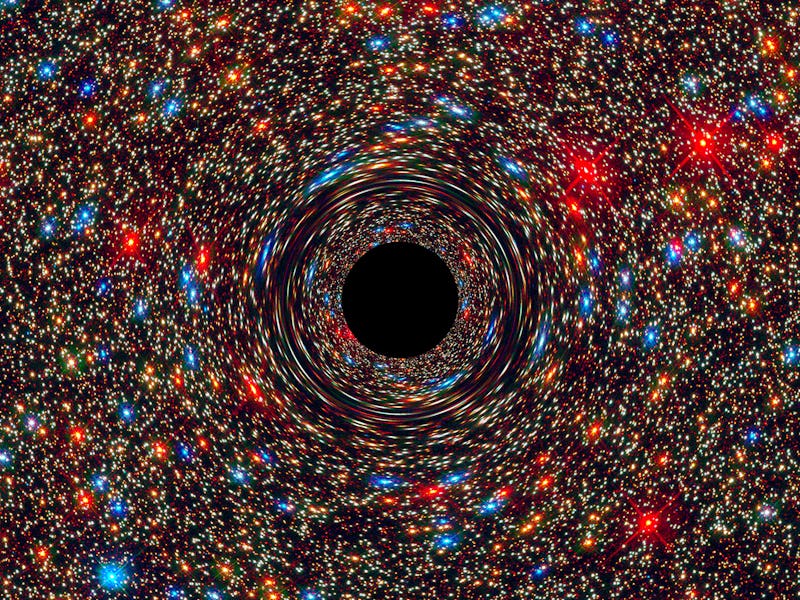Astronomers Say Supermassive Black Holes Might Actually Be Everywhere
Always the place you least expect.

Astronomers at the University of California, Berkeley have just discovered a record-breaking supermassive black hole with a mass equivalent to 17 billion suns sitting out in an otherwise relatively empty space in the universe. It’s an unusual finding that suggests these incredibly massive celestial phenomena are actually more common than we think, and may be present in the most unexpected of places.
“This hefty black hole is the first of its kind discovered outside of the most crowded areas of the universe,” UCB astronomer Chung-Pei Ma, the lead investigator of the research team, told Inverse. Typically, supermassive black holes of very large masses (around 10 billion times the sun) are located at the cores of big galaxies, which are themselves usually in regions of galactic clusters. “These privileged sites are rare, so these monster black holes should also be rare.” The biggest supermassive black hole on record so far is located in the galaxy NGC 4889 in the Coma Cluster, and tops in at 21 billion solar masses.
The new black hole, by contrast, was found in a galaxy 200 million light-years away called NGC 1600, which is pretty much as far away from the Coma Cluster as you can get. It’s a lot like the other 99.98 percent of the universe — meaning it’s mostly empty space. And finding a black hole just a few billion solar masses shy of the NGC 4889 behemoth in a region like this is totally unexpected.
The elliptical galaxy NGC 1600, 200 million light-years away, shown in the center of the image and highlighted in the box. It hosts one of the biggest supermassive black holes known
Things are also a big stranger when you consider what the solar mass estimates of these supermassive black holes actually mean. The upper limit of the NGC 4889 black hole is 21 billion solar masses, but the lower limit is actually 3 billion. Meanwhile, the NGC 1600 black hole is, more accurately speaking, between 15.5 to 18.5 billion solar masses.
All of this raises the question: is NGC 1600’s supermassive black hole just a one-off exception, or is it a more realistic illustration of how much more common supermassive black holes are in the world?
In the case of NGC 1600, the plot thickens a bit more. The stars around that galaxy are moving around as if the black hole were binary (i.e. two black holes orbiting one another at the galactic core). Binary black holes are thought to be pretty common in large galaxies, since galaxies grow by combining with other galaxies. If each has its own black hole, both of them would merge to the center of the new galaxy and orbit one-another until they collide.
That could be what’s at play with NGC 1600. And there’s a big reason Ma and her colleagues would be interested in finding out: if the center indeed used to be a pair of black holes that have merged, that event would produce gravitational waves which could be detected.
“These would be the supermassive version of the black hole binary detected by LIGO two months ago,” says Ma. The emitted waves would unfortunately be at frequencies much lower than are being targeted by LIGO and the upcoming eLISA mission, as well as other gravitational wave projects.
Nevertheless, the new findings might perhaps flip the script most scientists studying black holes have so far been following. “The relationship between black holes and their host galaxies is more intricate and depends on a black hole’s feeding history in addition to location” says Ma. “Finding more of these monster black holes will shape our understanding of the interplay between black holes and galaxies and how they behaved during the quasar phase in the young universe.”